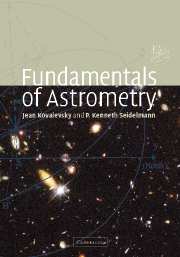Book contents
- Frontmatter
- Contents
- Preface
- List of abbreviations
- 1 Introduction
- 2 New observational techniques
- 3 Basic principles and coordinate systems
- 4 Treatment of astronomical data
- 5 Principles of relativity
- 6 Apparent displacements of celestial objects
- 7 Extragalactic reference frame
- 8 Dynamical reference frame
- 9 Terrestrial coordinate systems
- 10 Earth orientation
- 11 Stars
- 12 Double and multiple star systems
- 13 Astronomical phenomena
- 14 Applications to observations
- Appendix A Examples
- Appendix B Astronomical values
- Glossary
- References
- Index
14 - Applications to observations
Published online by Cambridge University Press: 05 November 2011
- Frontmatter
- Contents
- Preface
- List of abbreviations
- 1 Introduction
- 2 New observational techniques
- 3 Basic principles and coordinate systems
- 4 Treatment of astronomical data
- 5 Principles of relativity
- 6 Apparent displacements of celestial objects
- 7 Extragalactic reference frame
- 8 Dynamical reference frame
- 9 Terrestrial coordinate systems
- 10 Earth orientation
- 11 Stars
- 12 Double and multiple star systems
- 13 Astronomical phenomena
- 14 Applications to observations
- Appendix A Examples
- Appendix B Astronomical values
- Glossary
- References
- Index
Summary
The previous chapters have provided the bases for the applications to observations. This chapter will provide examples of the reduction and analysis of observational data. Software for coordinate conversions and individual effects, such as precession, nutation, proper motions, aberration, refraction, etc., is available as NOVAS at the US Naval Observatory website. A software program that performs on-line the full reduction of a CCD plate, called PRIAM, is available at the IMCCE web site of the Paris Observatory.
Observing differences, classical and new systems
In Chapters 7, 8, and 10, we introduced fixed and moving reference systems. At present, we are in a transition period, when old and new systems may be used, although it is to be expected that the new system will progressively remain the only one used, because they have important advantages. However, it is still necessary to be acquainted with both.
Referring positions to the fixed reference frame at epoch J2000.0, namely the International Celestial Reference Frame (ICRF), instead of the reference frame and positions referred to the equinox and the ecliptic and based on the FK5, improves the accuracies of the positions. The ephemerides are now on the ICRF. Astrometric observations made with respect to ICRF positions only require the corrections for proper motions of the reference stars and appropriate differential corrections to reduce the magnitudes of the plate solution parameters (Section 14.5).
- Type
- Chapter
- Information
- Fundamentals of Astrometry , pp. 323 - 352Publisher: Cambridge University PressPrint publication year: 2004



